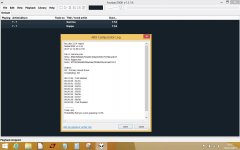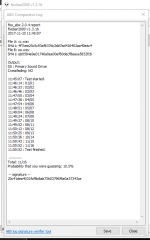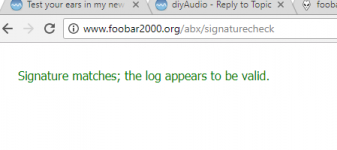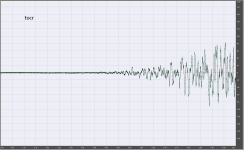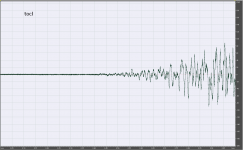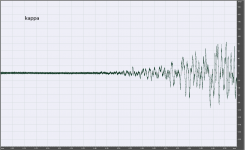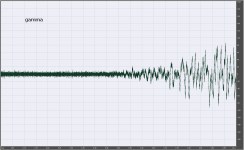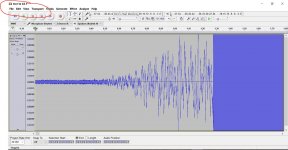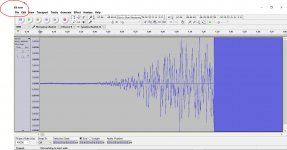In the latest Low Bias Texan test (violin Toccata, gamma and kappa files) I have been concentrated on first 3 seconds of the sound file, violin introduction. The first 3 seconds have ambient noise, violin sound, violin fade-out and reverberation. The crossover distortion of the low biased Texan changes the violin timbre a bit and also the reverberation fading in the ambient noise. Try it.
So I prepared 48/24 files with violin sound, linked again in the 1st post of the thread. We were not able to discern the OPA549 distortion again...
Not able? The files sound different to me. Agreed that nobody who could hear a difference bothered to suffer through an ABX test, and nobody bothered to cheat through one either. Unwilling and unable are not necessarily the same thing.
By the way, the reason I went directly out of the DAC headphone amp into headphones is because the file differences were too small to discern through the best power amp available here, a 20+ year old original Bryston 4B. No question they are small differences requiring exceptionally good reproduction equipment, but that doesn't mean the distortion is inaudible to all humans on all equipment.
It wouldn't surprise me if someone like Pano or Mooly could hear a difference in the files too, given access to good enough playback equipment. Let's not confuse limitations of their equipment with their human limitations. We haven't done tests to separate those variables yet, and we probably won't. In that case, the test is at best inconclusive.
Attached is a result of 1 inverted and both mixed tocl and tocr files...
Your result is correct. Now, when you amplify the difference between tocl and tocr by 36 dB, as I did with Karl's Texan files, you will hear that the amplified difference is linear, no crossover distortion audible. The difference reflects small phase shifts between the two files and there is no audible crossover distortion. The existing crossover distortion is below audibility thresholds of the human ear. That's the goal of this thread, to show that even crossover distortion below certain level is inaudible and to try to find some thresholds, at least for the test music sample. Karl's simulated Texan files have helped a lot.
What happens if you upsample the files and autocorrelate them in short sections to remove phase shift differences, or otherwise correct for phase differences? With enough gain, and done so as to best show any differences other than phase, I believe you will find there is a difference in dynamics of vibrato inflections. Either that, or you have found a way demonstrate audible distortion in a Benchmark DAC-3.
I am going to try these on a different setup later as I haven't been able to get a reliable ABX result on them so far.
Not able? The files sound different to me. Agreed that nobody who could hear a difference bothered to suffer through an ABX test, and nobody bothered to cheat through one either. Unwilling and unable are not necessarily the same thing
Mark, I appreciate your comments, but until you have a repeatable ABX result I do not take them serious. To me, they are one of the audiophiles stories, folklore. I believe that you believe that you are hearing the difference, but at least IMO you are just fooling yourself. This is nothing wrong with you, it is just the way how the brain controlled human hearing works. It is called psycho-acoustics and it is a scientific discipline. You hear it (in your opinion), but you are unable to prove it. Like the maths student at the blackboard who knows how to calculate the formula under question but is unable to show it when standing at the blackboard with chalk in his hand.
Mooly, ABX or not, can you repeatably hear a difference between the files when blinded to which one is which? That is a different question from whether or not you can do it many times in a row without losing focus.
What happens if you upsample the files and autocorrelate them in short sections to remove phase shift differences, .
Those phase shift differences between tocl and tocr are orders below ability of human ear to discern. I am sorry I will not react to speculations anymore.
You may not test the modified files, you may only test the existing files. That's why I insist on complete ABX protocol with SHA codes and digital signature.
Mark, I appreciate your comments, but until you have a repeatable ABX result I do not take them serious. To me, they are one of the audiophiles stories, folklore. I believe that you believe that you are hearing the difference, but at least IMO you are just fooling yourself. This is nothing wrong with you, it is just the way how the brain controlled human hearing works. It is called psycho-acoustics and it is a scientific discipline. You hear it (in your opinion), but you are unable to prove it. Like the maths student at the blackboard who knows how to calculate the formula under question but is unable to show it when standing at the blackboard with chalk in his hand.
So, what ABX score would it take to convince you?
As a separate question, do you mind if I cheat if you can't prove I cheated? In other words, if I provide the exact score you specify, you will be satisfied, is that right?
The last night,
With ODAC -> AV Marantz SR 4500 -> KEF Q100 speakers, W10 Pro 1511 compilation and very optimized.
With the last beta JRiver Media Center 23.0.81 JRiver Media Center 23.0.81 -- Available Here
tocl.wav vs tocr.wav
*With Asio4All 2.13 (by the way, 2.14 sounds worse in my system)
I can differentiate. I prefer tocr.wav
*With DirectSound (aka DS)
I can differentiate. I prefer tocr.wav
* With Kernel Streaming.
I can differentiate. I prefer tocl.wav (like with AIMP3)
With ODAC -> AV Marantz SR 4500 -> KEF Q100 speakers, W10 Pro 1511 compilation and very optimized.
With the last beta JRiver Media Center 23.0.81 JRiver Media Center 23.0.81 -- Available Here
tocl.wav vs tocr.wav
*With Asio4All 2.13 (by the way, 2.14 sounds worse in my system)
I can differentiate. I prefer tocr.wav
*With DirectSound (aka DS)
I can differentiate. I prefer tocr.wav
* With Kernel Streaming.
I can differentiate. I prefer tocl.wav (like with AIMP3)
Here we are then. One file is one of the original files (tocl or tocr, you don't know which) converted to 16/44.1 and the other file is via the Texan running normal bias. The final second on both is cropped because I looked at the properties of the original and it was listed as 1'54" and set the simulation to run for 114 seconds but it seems its actually nearer 1'55".
(although LT seemed to accept a 48k input file, it does not seem to output to a 48k file. The sim appears to run but stalls part way through leaving the output file blank. I recall reading in the LT manual by Gilles Brocard that it has to be 16/44.1)
TEXAN BACH
Well (JRiver and Asio4All), Alpha was the worse, aka tocl.wav
**************** **************** ***************** ****************
With foobar2000 and JRiver I have always equalized my KEF Q100 speakers with this:
An externally hosted image should be here but it was not working when we last tested it.
Two notch at 65 Hz (Woofer fs) and the armonic 130 Hz. And a LPF at 19830 Hz with Q=0.7. Before attenuating noise, interference, continous, speaker mods... , the LPF was < 15000 Hz, 16000 Hz, 18000 Hz, 19000 Hz and finally the 19830 Hz.
KEF Q100 Uni Q bookshelf speakers. 5.25" coaxial with front bass reflex.
130 Hz is the armonic and the valley.
An externally hosted image should be here but it was not working when we last tested it.
Last edited by a moderator:
Nice result.
I have some new one, as well. Not too bad, I would say 😉
I made several trials and all positive. And yes, easier with DacMagic. So I assume the audibility of the crossover distortion in Karl's low bias Texan is proven.
I have some new one, as well. Not too bad, I would say 😉
Code:
foo_abx 2.0.2 report
foobar2000 v1.3.7
2017-11-10 12:49:56
File A: Gamma.wav
SHA1: 8f6a78d92a6752ea8130de2bd3017537bace4b1f
File B: Kappa.wav
SHA1: df779c38529b3fbad3ae70fdd6233e301ad747c7
Output:
WASAPI (event) : Speakers (Cambridge Audio USB Audio 1.0), 24-bit
Crossfading: NO
12:49:56 : Test started.
12:50:48 : 01/01
12:50:58 : 02/02
12:51:10 : 03/03
12:51:27 : 04/04
12:51:35 : 05/05
12:51:48 : 06/06
12:52:03 : 07/07
12:52:08 : 08/08
12:52:15 : 09/09
12:52:24 : 10/10
12:52:39 : 11/11
12:52:53 : 12/12
12:53:09 : 13/13
12:53:21 : 14/14
12:53:35 : 15/15
12:53:46 : 16/16
12:53:46 : Test finished.
----------
Total: 16/16
Probability that you were guessing: 0.0%
-- signature --
0facd7797ca8e12d293957c57ad51999e402724cI made several trials and all positive. And yes, easier with DacMagic. So I assume the audibility of the crossover distortion in Karl's low bias Texan is proven.
I can see that the low bias version (kappa) is not resolving the very low level noise/hash in the silent part. Due to the limitations of exporting files in LTSpice the originals had to be down converted to 44.1k unfortunately.
Gamma was tocr 🙂
I've just tried converting tocr again and looked at it in Audacity and can see the added hash compared to the original.
Gamma was tocr 🙂
I've just tried converting tocr again and looked at it in Audacity and can see the added hash compared to the original.
Attachments
Yes, but interestingly enough "kappa" (file B in my ABX) was noisier by ear in the beginning of the music sample. tocr or tocl made not much difference for your choice. You can also see that your gamma, 44.1/16 resampled from 48/24 tocr, is noisier than both tocl or tocr.
Karl, if you have the Rotel files prepared, go on and post them, and let's have continuing fun in this thread.
Karl, if you have the Rotel files prepared, go on and post them, and let's have continuing fun in this thread.
Gamma was tocr 🙂
I said
I do not tried with Lacinato ABX but I guess I could not differentiate yours like the originals at 24/48. But with JRiver I can differentiate! 😀Well (JRiver and Asio4All), Alpha was the worse, aka tocl.wav
- Status
- Not open for further replies.
- Home
- General Interest
- Everything Else
- Test your ears in my new ABX test
